Abstract
The chromatin of most cell types contains several different sequence variants of histone H1. The functional role of this heterogeneity is not known. In the larval tissues of the midge, Chironomus thummi, there are H1 variants of two types. H1 II-1, H1 II-2, and H1 III-1 have similar amino acid sequences and appear uniformly distributed in polytene interphase chromosomes. The total number of gene copies per genome for this type of H1 histones is about 40 in C. th. thummi and 50-60 in C. th. piger. In contrast, histone H1 I-1 is encoded by a single copy gene in C. th. thummi and by two to four genes in C. th. piger. It has a divergent structure and is found only in a limited number of condensed chromosome sites. The N-terminal domain of H1 I-1 contains an insertion that is lacking in the other H1 variants and that is part of a variant-specific bipartite sequence Lys-Ala-Pro-Lys-Ala-Pro-Xaa10-Lys-Val-Ala in front of the conserved central domain. N-terminal peptides of H1 I-1 including this motif, in contrast to the homologous peptide from H1 II-1, competed with the drug Hoechst 33258 for binding to the minor groove of the DNA double helix. Repeats of the sequence Lys-Ala-Pro are also present at the same distance from the conserved central domain, in a single H1 variant of a nematode and of a green alga. The motif could interact with linker DNA in intranuclear targeting or packaging a condensed subtype of chromatin, or both.
Full text
PDF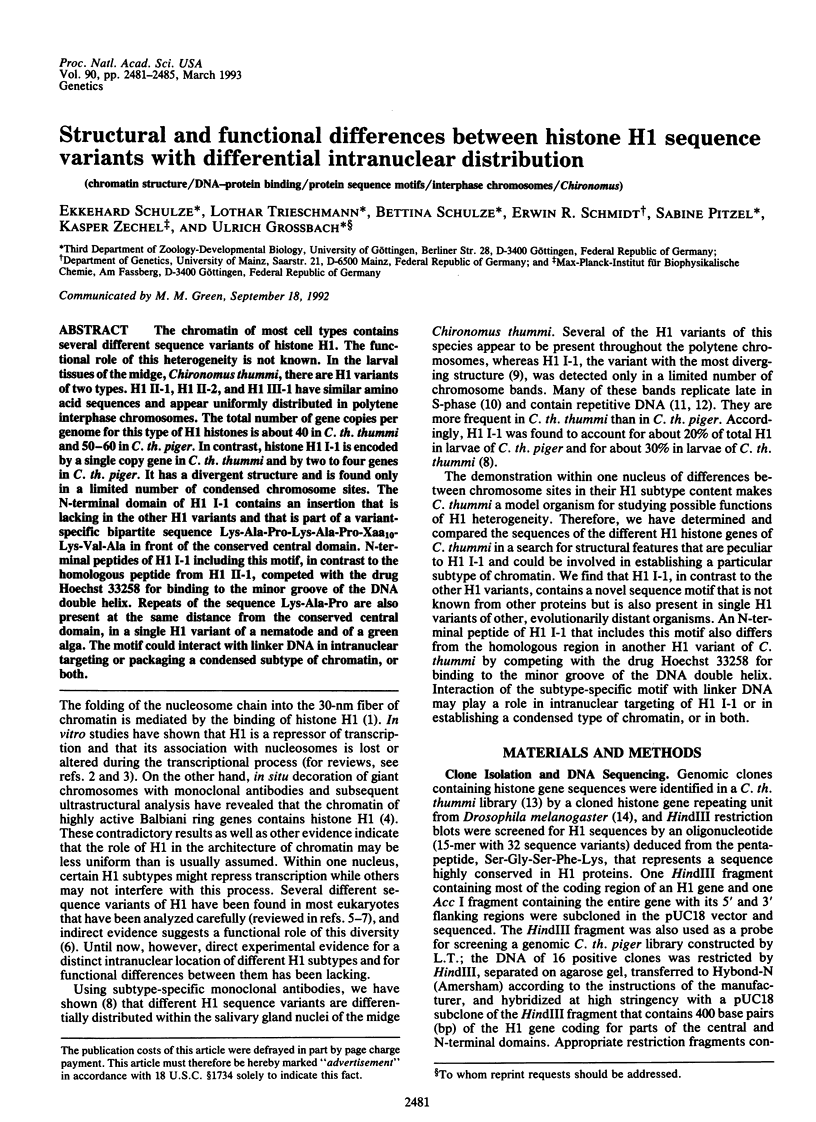
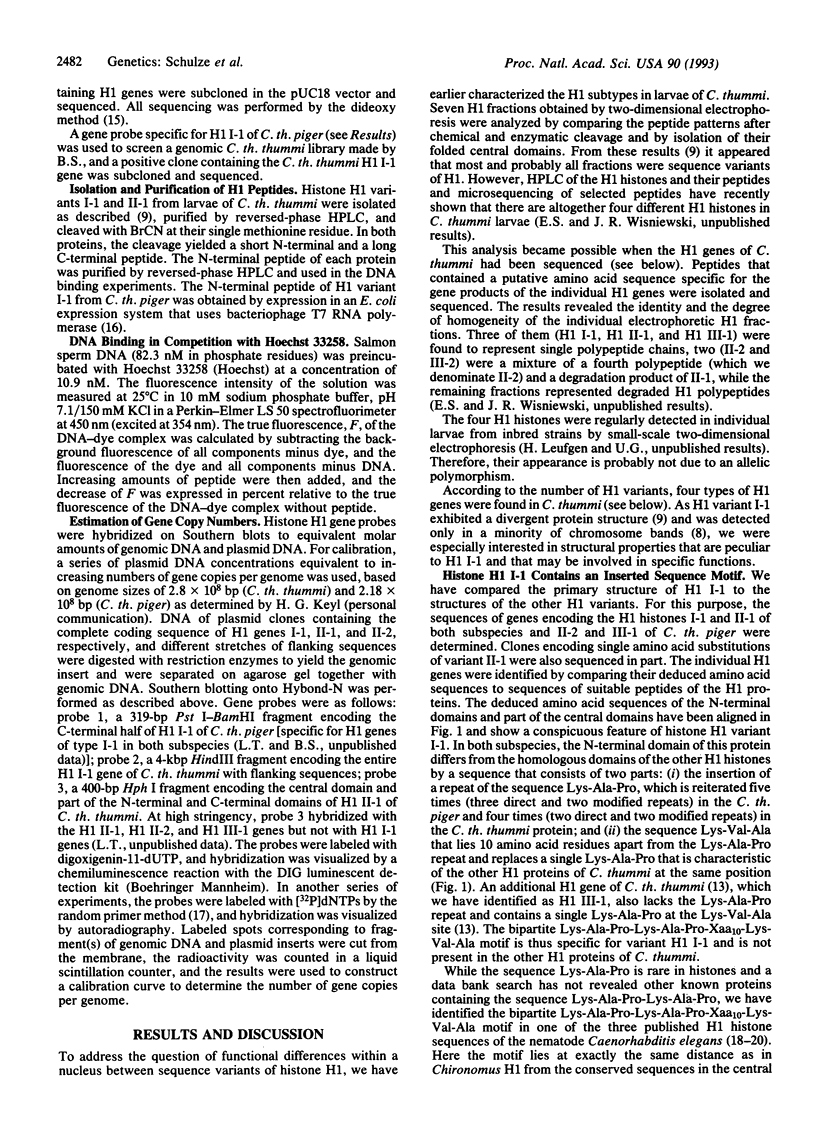
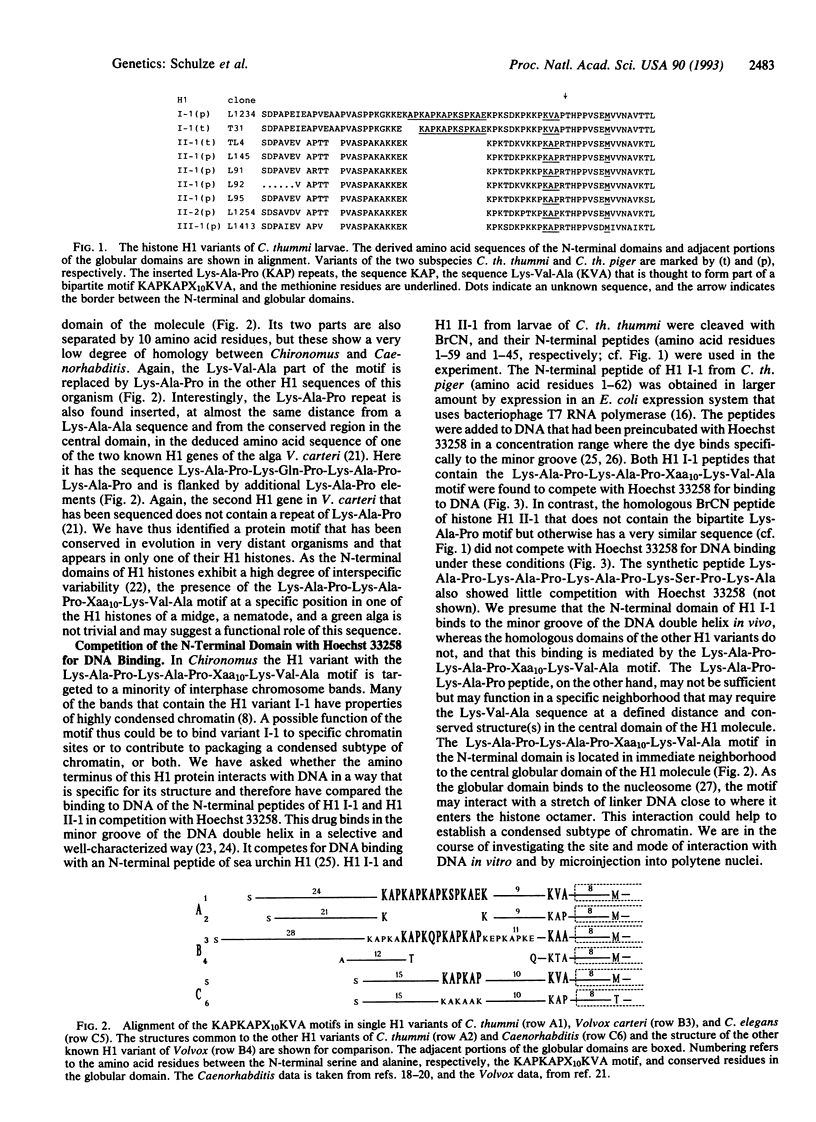
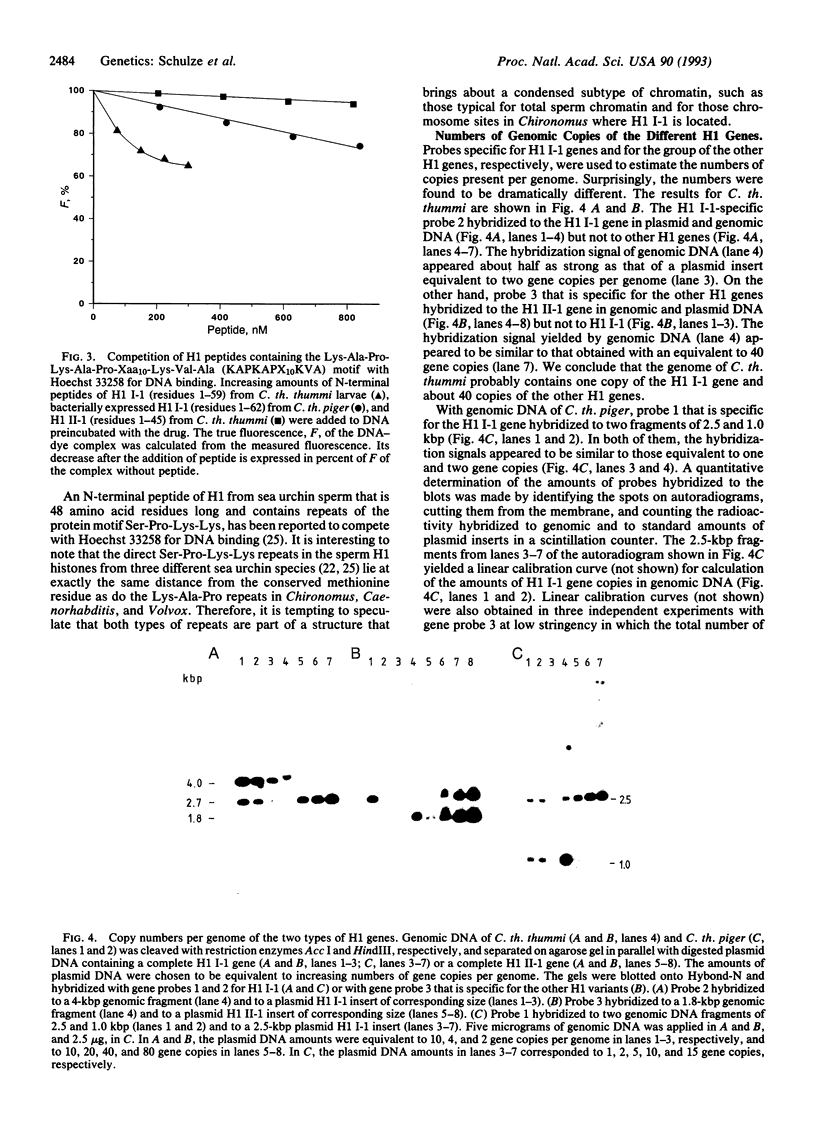
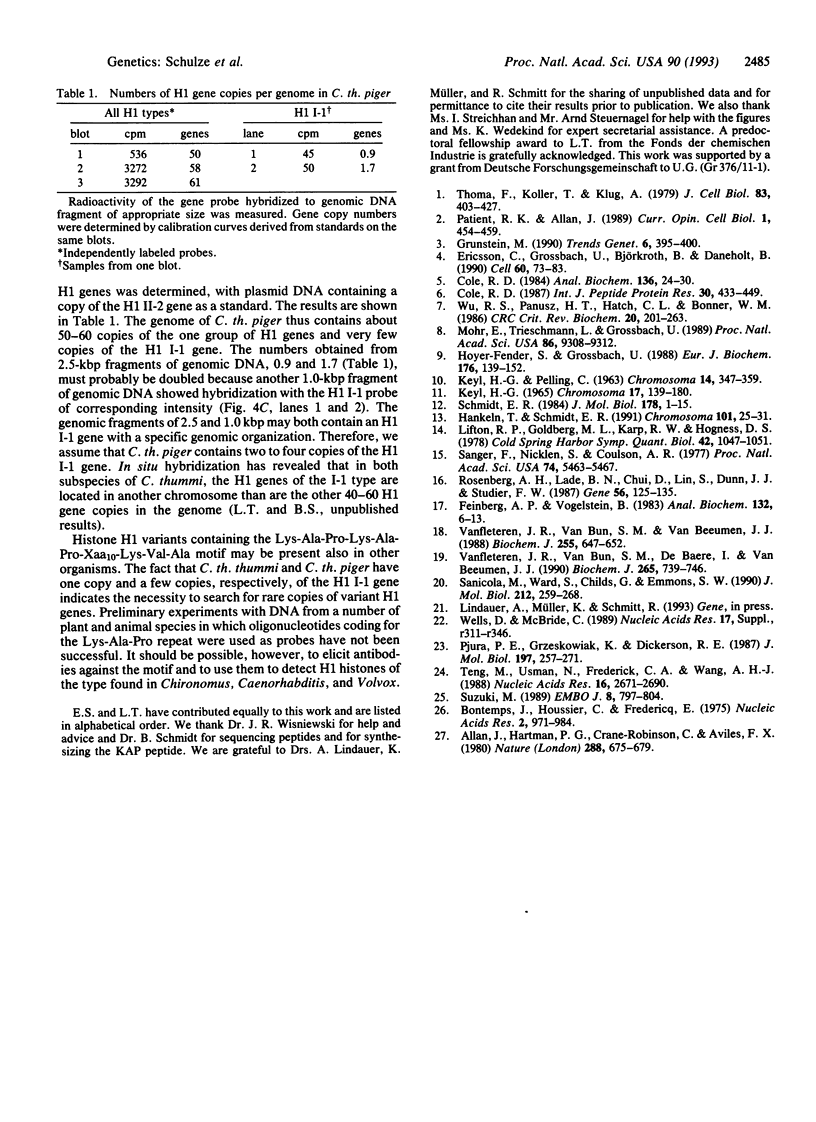
Images in this article
Selected References
These references are in PubMed. This may not be the complete list of references from this article.
- Allan J., Hartman P. G., Crane-Robinson C., Aviles F. X. The structure of histone H1 and its location in chromatin. Nature. 1980 Dec 25;288(5792):675–679. doi: 10.1038/288675a0. [DOI] [PubMed] [Google Scholar]
- Bontemps J., Houssier C., Fredericq E. Physico-chemical study of the complexes of "33258 Hoechst" with DNA and nucleohistone. Nucleic Acids Res. 1975 Jun;2(6):971–984. doi: 10.1093/nar/2.6.971. [DOI] [PMC free article] [PubMed] [Google Scholar]
- Cole R. D. A minireview of microheterogeneity in H1 histone and its possible significance. Anal Biochem. 1984 Jan;136(1):24–30. doi: 10.1016/0003-2697(84)90303-8. [DOI] [PubMed] [Google Scholar]
- Cole R. D. Microheterogeneity in H1 histones and its consequences. Int J Pept Protein Res. 1987 Oct;30(4):433–449. doi: 10.1111/j.1399-3011.1987.tb03352.x. [DOI] [PubMed] [Google Scholar]
- Ericsson C., Grossbach U., Björkroth B., Daneholt B. Presence of histone H1 on an active Balbiani ring gene. Cell. 1990 Jan 12;60(1):73–83. doi: 10.1016/0092-8674(90)90717-s. [DOI] [PubMed] [Google Scholar]
- Feinberg A. P., Vogelstein B. A technique for radiolabeling DNA restriction endonuclease fragments to high specific activity. Anal Biochem. 1983 Jul 1;132(1):6–13. doi: 10.1016/0003-2697(83)90418-9. [DOI] [PubMed] [Google Scholar]
- Grunstein M. Nucleosomes: regulators of transcription. Trends Genet. 1990 Dec;6(12):395–400. doi: 10.1016/0168-9525(90)90299-l. [DOI] [PubMed] [Google Scholar]
- Hankeln T., Schmidt E. R. The organization, localization and nucleotide sequence of the histone genes of the midge Chironomus thummi. Chromosoma. 1991 Oct;101(1):25–31. doi: 10.1007/BF00360683. [DOI] [PubMed] [Google Scholar]
- Hoyer-Fender S., Grossbach U. Histone H1 heterogeneity in the midge, Chironomus thummi. Structural comparison of the H1 variants in an organism where their intrachromosomal localization is possible. Eur J Biochem. 1988 Sep 1;176(1):139–152. doi: 10.1111/j.1432-1033.1988.tb14261.x. [DOI] [PubMed] [Google Scholar]
- Keyl H. G. Duplikationen von Untereinheiten der Chromosomalen DNS während der Evolution von Chironomus thummi. Chromosoma. 1965;17(2):139–180. doi: 10.1007/BF00330079. [DOI] [PubMed] [Google Scholar]
- Lifton R. P., Goldberg M. L., Karp R. W., Hogness D. S. The organization of the histone genes in Drosophila melanogaster: functional and evolutionary implications. Cold Spring Harb Symp Quant Biol. 1978;42(Pt 2):1047–1051. doi: 10.1101/sqb.1978.042.01.105. [DOI] [PubMed] [Google Scholar]
- Mohr E., Trieschmann L., Grossbach U. Histone H1 in two subspecies of Chironomus thummi with different genome sizes: homologous chromosome sites differ largely in their content of a specific H1 variant. Proc Natl Acad Sci U S A. 1989 Dec;86(23):9308–9312. doi: 10.1073/pnas.86.23.9308. [DOI] [PMC free article] [PubMed] [Google Scholar]
- Patient R. K., Allan J. Active chromatin. Curr Opin Cell Biol. 1989 Jun;1(3):454–459. doi: 10.1016/0955-0674(89)90005-7. [DOI] [PubMed] [Google Scholar]
- Pjura P. E., Grzeskowiak K., Dickerson R. E. Binding of Hoechst 33258 to the minor groove of B-DNA. J Mol Biol. 1987 Sep 20;197(2):257–271. doi: 10.1016/0022-2836(87)90123-9. [DOI] [PubMed] [Google Scholar]
- Rosenberg A. H., Lade B. N., Chui D. S., Lin S. W., Dunn J. J., Studier F. W. Vectors for selective expression of cloned DNAs by T7 RNA polymerase. Gene. 1987;56(1):125–135. doi: 10.1016/0378-1119(87)90165-x. [DOI] [PubMed] [Google Scholar]
- Sanger F., Nicklen S., Coulson A. R. DNA sequencing with chain-terminating inhibitors. Proc Natl Acad Sci U S A. 1977 Dec;74(12):5463–5467. doi: 10.1073/pnas.74.12.5463. [DOI] [PMC free article] [PubMed] [Google Scholar]
- Sanicola M., Ward S., Childs G., Emmons S. W. Identification of a Caenorhabditis elegans histone H1 gene family. Characterization of a family member containing an intron and encoding a poly(A)+ mRNA. J Mol Biol. 1990 Mar 20;212(2):259–268. doi: 10.1016/0022-2836(90)90123-4. [DOI] [PubMed] [Google Scholar]
- Schmidt E. R. Clustered and interspersed repetitive DNA sequence family of Chironomus. The nucleotide sequence of the Cla-elements and of various flanking sequences. J Mol Biol. 1984 Sep 5;178(1):1–15. doi: 10.1016/0022-2836(84)90227-4. [DOI] [PubMed] [Google Scholar]
- Suzuki M. SPKK, a new nucleic acid-binding unit of protein found in histone. EMBO J. 1989 Mar;8(3):797–804. doi: 10.1002/j.1460-2075.1989.tb03440.x. [DOI] [PMC free article] [PubMed] [Google Scholar]
- Teng M. K., Usman N., Frederick C. A., Wang A. H. The molecular structure of the complex of Hoechst 33258 and the DNA dodecamer d(CGCGAATTCGCG). Nucleic Acids Res. 1988 Mar 25;16(6):2671–2690. doi: 10.1093/nar/16.6.2671. [DOI] [PMC free article] [PubMed] [Google Scholar]
- Thoma F., Koller T., Klug A. Involvement of histone H1 in the organization of the nucleosome and of the salt-dependent superstructures of chromatin. J Cell Biol. 1979 Nov;83(2 Pt 1):403–427. doi: 10.1083/jcb.83.2.403. [DOI] [PMC free article] [PubMed] [Google Scholar]
- Vanfleteren J. R., Van Bun S. M., De Baere I., Van Beeumen J. J. The primary structure of a minor isoform (H1.2) of histone H1 from the nematode Caenorhabditis elegans. Biochem J. 1990 Feb 1;265(3):739–746. doi: 10.1042/bj2650739. [DOI] [PMC free article] [PubMed] [Google Scholar]
- Vanfleteren J. R., Van Bun S. M., Van Beeumen J. J. The primary structure of the major isoform (H1.1) of histone H1 from the nematode Caenorhabditis elegans. Biochem J. 1988 Oct 15;255(2):647–652. [PMC free article] [PubMed] [Google Scholar]
- Wells D., McBride C. A comprehensive compilation and alignment of histones and histone genes. Nucleic Acids Res. 1989;17 (Suppl):r311–r346. doi: 10.1093/nar/17.suppl.r311. [DOI] [PMC free article] [PubMed] [Google Scholar]
- Wu R. S., Panusz H. T., Hatch C. L., Bonner W. M. Histones and their modifications. CRC Crit Rev Biochem. 1986;20(2):201–263. doi: 10.3109/10409238609083735. [DOI] [PubMed] [Google Scholar]



